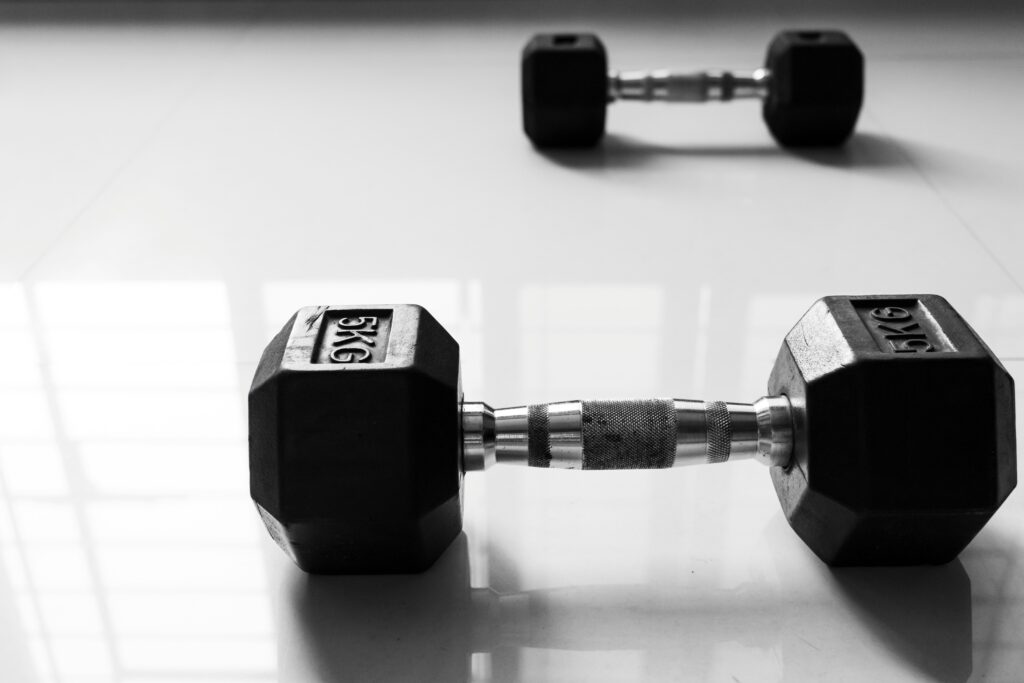
Article at a Glance
- Gym progress has less to do with effort and more to do with direction.
- Mistakes like skipping foundational movements, rushing reps, or training without a plan stem from misunderstood priorities, not laziness.
- Avoiding these five common pitfalls helps you build strength, consistency, and confidence that lasts far beyond the gym.
If walking into the gym feels a little overwhelming, you’re not alone. Between the machines you don’t recognize, the routines that all promise quick results, and the pressure to “do it right,” it’s easy to overthink, overdo, or overlook what really matters.
The truth? Most people aren’t held back by a lack of effort. They’re held back by a handful of avoidable mistakes like rushing reps, training without a plan, letting ego call the shots, or thinking that if they can’t be perfect, there’s no point at all.
Whether you’re brand new or just getting back into the groove, this article unpacks the five most common gym mistakes I see as a personal trainer and how fixing them can change everything from how you move to how you think about fitness in the long run.
1. Skipping the Basics: Why Movement Matters More Than Machines
Let’s be honest: the basics aren’t sexy. But they’re essential.
Too many people skip straight to flashy exercises like box jumps or complex routines without understanding how their body moves. They swap traditional free weight lifts like squats or presses for machines that let them load up the weight, or look to social media for the latest trendy exercise because they look cooler or feel easier.
But here’s the truth: foundational movement patterns — like squatting, hinging, pushing, pulling, and lunging — are the bedrock of strength, mobility, and injury prevention. Skipping them or doing them poorly leads to muscle imbalances, stalled progress, and sometimes pain.
One of the biggest issues when performing these lifts? People avoid full ranges of motion. Usually for one of two reasons:
- They’re not strong enough to control the movement through the entire range.
- They don’t have the mobility to access that range in the first place.
Instead, they work within the range they have — half squats, half pull-ups, half presses. Over time, that becomes the range their body adapts to. The areas they avoid stay weak and immobile, and the compensation only gets worse.
Here’s the thing: you can build that range, but it takes time. And trying to force your way into a position you can’t control is how injuries happen. The key is to build strength through the range you can access, and gradually expand it over time. Not by chasing depth or length recklessly, but by earning it one inch at a time.
If flashy movement is your endgame, here’s the hard truth: the fastest way to move like an athlete is to train like a beginner. The people doing advanced lifts or acrobatics didn’t skip steps. They built capacity through boring, high-quality reps of the basics long before they added flair.
Better approach:
Start by performing exercises at the full ranges you have access to for squats, split squats, and deadlifts. For the upper body, focus on overhead pressing, dips, pull-ups, and rows. If you can move through the full range of these patterns with control and confidence, you’ll have a foundation most people skip entirely.
And it’s not just about the gym. Squatting mimics sitting and standing. Deadlifts teach you to pick things up safely. Pulling and pressing keep your shoulders strong and mobile, something you’ll be grateful for when you’re still reaching overhead effortlessly in your 70s.
This isn’t just a theory, I’ve seen it firsthand. I once had a client who couldn’t raise his arms overhead after an injury. He couldn’t reach above eye level. Over the course of a year, we slowly rebuilt his mobility and strength. There were no gimmicks and no flashy moves. Just deliberate progressions rooted in basic patterns. By the end, he was pain-free and fully functional, able to do things he thought he’d lost forever.
So forget “advanced.” The basics are advanced if you do them right.
2. Training Without a Plan (a.k.a. The “Random Acts of Fitness” Approach)
You wouldn’t build a house by winging it, so why treat your health that way?
One of the easiest ways to tell someone is winging it in the gym? They do something different every day — different exercises, different machines, no clear rep structure, and no progression. You’ll also see people jumping back and forth between easy and hard exercises, like starting a session with bicep curls and finishing with deadlifts. That’s a recipe for wasted effort. In a good plan, harder, more demanding lifts come first when your body is fresh, not when it’s already fatigued.
Another red flag? People doing five different exercises for the same muscle group on five different machines, thinking that just because the equipment is different, the stimulus must be, too. In reality, they’re repeating the same range of motion over and over and calling it variety. And on the flip side, some people get stuck doing the exact same thing for months because it’s familiar and easy. The truth? Progress lives somewhere between these two extremes.
Why this matters:
A plan gives you structure, and structure gives you feedback. Without it, you can’t measure progress, so motivation fades fast. You also run the risk of reinforcing poor movement patterns or overworking the same joints without even realizing it.
Most people don’t avoid structured training on purpose. Most of us assume we know how to train effectively, so we just do what feels natural. But that assumption — paired with confusion, embarrassment, and the cost of good coaching — often leads people into a loop of trial-and-error. And with the personal training industry being what it is, it’s no wonder people feel stuck.
Better approach:
Start with consistency, not complexity. You don’t need a complicated program to see results, you need a plan you can stick to and adjust over time. If you train two days per week, a full-body routine is your best friend. If you train three or more, upper/lower splits can be a great step forward. Stick with a specific set of exercises for 6–10 workouts before switching things up. Focus on compound lifts that challenge the range of motion you have, and incorporate mobility work to expand that range gradually.
The bigger lesson to learn here is that results take time. Anyone can work hard for a week, but committing to a structure and seeing it through builds the kind of discipline that spills over into everything else. If you can delay gratification in the gym, you’re more likely to do it in the kitchen. And that’s where body composition change really begins.
So don’t fall into the trap of chasing novelty. Chase progress. Show up with a plan, and your body — and mindset — will change with it.
3. Rushing Reps: Why Tempo and Control Matter More Than You Think
Tempo is simply how fast or slow you perform each part of an exercise, and whether you’re in control of the weight the entire time. For example, taking two seconds to lower the weight and two seconds to lift it is a great place to start.
Most people don’t think about it. They just lift the weight and drop it back down. But the speed of your reps can make or break your progress.
The most common mistake? Moving too fast. You’ll see people bounce the bar off their chest, drop into squats like a trap door, or swing weights using momentum instead of muscle. They let the weight lead the movement rather than leading it themselves.
Here’s the rule: the weight shouldn’t control you, you should control the weight. When you rush your reps, you reduce the stimulus on your muscles and increase the strain on your joints. It might look like you’re doing more, but you’re actually doing less of what matters.
Controlling tempo makes every rep more effective. It forces your muscles to work harder. It reduces the risk of injury. It brings awareness to the movement, and most importantly, it builds real strength, not just the illusion of it.
People often mistake fast reps for hard work, but if you slow down and match your speed on the way up and the way down, you’ll feel the difference immediately. You don’t need a stopwatch or a complicated counting system, just match your pace in both directions and stay in control.
Better approach:
Focus on control over speed. If your reps are smooth, steady, and deliberate — without bouncing, jerking, or collapsing — you’re doing it right. The goal isn’t to move the weight fast. It’s to move the weight well.
And here’s the deeper part: training with control builds more than just muscle. It builds patience. Discipline. Focus. The kind of qualities that carry far beyond the gym.
So next time you’re tempted to race through a set, remember: slowing down isn’t a step back, it’s a sign you’re finally training with purpose.
4. Letting Ego Lead: When More Weight Means Less Progress
There’s a difference between training with confidence and training with ego. Confidence helps you slow down, dial in your form, and grind out quality reps. Ego has you chasing weight for weight’s sake, sacrificing control and technique just to say you did it.
You see it in the gym all the time: shortened ranges of motion, sloppy reps, jerking the weight through space, or bouncing out of the bottom of a lift. Yes, they “got the rep,” but they didn’t get the result. Because real progress isn’t about moving the weight, it’s about moving well.
Here’s the hard truth: it takes more confidence to lift less with perfect form than to lift more with poor form. It takes even more to keep doing it when everyone around you is chasing numbers. But over time, people will start asking you how you got stronger, leaner, and more capable because it will show.
Why ego takes over:
Ego lifting usually stems from insecurity and comparison. People want to prove something to others or to themselves. This is exacerbated by social media glorifying the biggest lifts and wildest feats, while conveniently leaving out the years of foundational work that came first or the injuries that come from skipping this step.
Take my client who had a history of hernias and chronic back pain. His training background was full of maxing out too often, with poor form, and lifting to impress. When he came to me, he wanted to pick up where he left off years ago. But we stripped it all back, rebuilt his movement, added range, and balanced his strength. Within a year, he was lifting almost as much as before and without pain.
Better approach:
The strongest athletes in the world don’t max out every day. Most of them train at 75–85% of their max. That’s the sweet spot for progress. Pushing harder than that too often just leads to burnout or breakdown.
The gym isn’t a proving ground, it’s a training ground. The goal isn’t to lift the most today. It’s to build the most potential over time.
Don’t measure your worth by what’s on the bar. Use the bar to build a stronger version of yourself so you can move better, live better, and do the things that matter outside the gym with more ease and less pain.
5. All or Nothing Thinking: The Fastest Way to Burn Out
“I missed Monday, so this week’s a wash.”
“If I can’t go five days, what’s the point?”
“I had one bad meal, might as well eat junk all day.”
Sound familiar?
All-or-nothing thinking is one of the most common reasons people fall off track. It turns progress into a perfection contest, and perfection is always a losing game. If you miss a day, you don’t need to hit the self-destruct button on the rest of the week.
This mindset shows up in the gym, in nutrition, and eventually in every corner of your life. When you treat one missed day like failure, you begin to normalize quitting, and that belief can quietly bleed into every part of your life. The truth is, how you do anything reflects how you’ll eventually approach everything.
Why this happens:
Most people don’t set out to self-sabotage. They just aim too high, too fast. They try to take on the habits of someone five steps ahead of them. When they inevitably fall short, it becomes easier to do nothing than to scale it back and do what’s realistic.
That’s not failure, that’s a mismatch of identity and expectation. You’re not doing the wrong things, you’re trying to live out a version of success that doesn’t fit yet. And when that happens, we feel guilt for slipping up and shame for not being further along. But guilt and shame don’t produce better habits. They produce avoidance.
Better approach:
Progress should be as slow as it needs to be to build momentum. If you miss a workout, don’t beat yourself up. Show up the next day. If you had a bad meal, it’s just that—a meal, not a pattern. Sustainability always wins.
Real results come from learning how to keep going when things aren’t perfect. Some days, the weights feel light. Other days, just getting to the gym is the win. And occasionally, life gets in the way and you miss the day. That’s not failure. That’s life. The key is that you don’t let one off day become a reason to quit altogether.
Every action you take is a vote for the type of person you want to become. You don’t need to be flawless. You need to be consistent. And consistency doesn’t mean intensity, it means showing up, even if it’s not your best.
LiveComplete Takeaways
- Most people don’t fail in the gym because of lack of effort, they fail because they’re focused on the wrong things.
- From skipping foundational movements to chasing heavy weights or perfection, these five mistakes all come down to misaligned priorities and misunderstood progress.
- Getting strong, staying consistent, and building a body that lasts starts with mindset, structure, and patience, not shortcuts or intensity alone.
When it comes to making progress in the gym, it’s not about perfection, it’s about showing up with intention. These five mistakes reveal how easily people can get off track by focusing on the wrong things, pushing too hard too soon, or giving up when things don’t go perfectly. The antidote isn’t doing more, it’s doing what matters, consistently and intentionally.
Start where you are. Be patient. Fuel your performance with a clean source of plant protein like LiveComplete NutriMatch™ and remember: progress isn’t about doing more, it’s about doing what matters, consistently.



